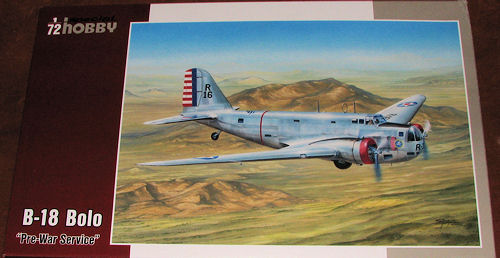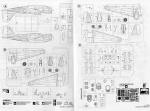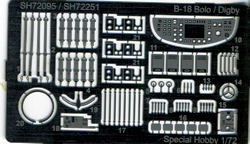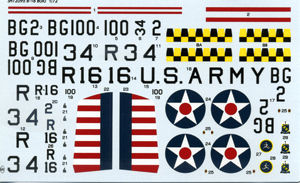
| KIT #: | SH 72095 |
| PRICE: | $51.29 |
| DECALS: | Four options |
| REVIEWER: | Scott Van Aken |
| NOTES: | Short run kit with photo etch and resin parts |

| HISTORY |
The Douglas B-18 Bolo bomber served with the United States Army Air Corps and the Royal Canadian Air Force (as the Douglas Digby) during the late 1930s and early 1940s. The Bolo was built by Douglas Aircraft Company and based on its DC-2 and was developed to replace the Martin B-10.
By 1940 it was considered to be underpowered, to have inadequate defensive armament and carried too small a bomb load. Many were destroyed during the attacks on Pearl Harbor and the Philippines in December 1941.
In 1942 the B-18 survivors were relegated to antisubmarine or transport duty. A B-18 was one of the first American aircraft to sink a German U-Boat, the U-654 on 22 August 1942 in the Caribbean.
The initial contract called for 133 B-18s (including DB-1), using Wright R-1820 radial engines. The last B-18 of the run, designated DB-2 by the company, had a power-operated nose turret. This design did not become standard. Additional contracts in 1937 (177 aircraft) and 1938 (40 aircraft) were for theB-18A, which had the bombardier's position further forward over the nose-gunner's station. The B-18A also used more powerful engines.
Deliveries of B-18s to Army units began in the first half of 1937, with the first examples being test and evaluation aircraft being turned over to the Materiel Division at Wright Field, Ohio, the Technical Training Command at Chanute Field, Illinois, the Aberdeen Proving Ground, Maryland, and Lowry Field, Colorado. Deliveries to operational groups began in late 1937, the first being the 7th Bombardment Group at Hamilton Field, California.
Production B-18s, with full military equipment fitted, had a maximum speed of 217 mph, cruising speed of 167 mph, and combat range of 850 miles. Nevertheless, the B-18 was the most modern bomber design then available. By 1940, most USAAC bomber squadrons were equipped with B-18s or B-18As.
However, the deficiencies in the B-18/B-18A bomber were becoming readily apparent to almost everyone. In range, in speed, in bomb load, and particularly in defensive armor and armament, the design came up short, and the USAAF conceded that the aircraft was totally unsuited in the long-range bombing role for which it had originally been intended. To send crews out in such a plane against a well-armed, determined foe would have been nothing short of suicidal.
However, in spite of the known shortcomings of the B-18/B-18A, the Douglas aircraft was the most numerous American bomber type deployed outside the continental United States at the time of the attack on Pearl Harbor. It was hoped that the B-18 could play a stopgap role until more suitable aircraft such as the Boeing B-17 Flying Fortress and Consolidated B-24 Liberator became available in quantity.
| THE KIT |
 This particular Special Hobby kit has been much anticipated by several modelers. The B-18 is an aircraft that has not been done before in this or any other scale as an injected kit. Fortunately, we now have both the early and later versions. This is the early version, and to my eyes, the better looking of the two.
This particular Special Hobby kit has been much anticipated by several modelers. The B-18 is an aircraft that has not been done before in this or any other scale as an injected kit. Fortunately, we now have both the early and later versions. This is the early version, and to my eyes, the better looking of the two.
If you have built an MPM/Special Hobby/Azur kit in the last ten years, you will find this one pretty much like the others in terms of its high quality of molding and its short run assembly. By that I mean there are no alignment pins and you need to test fit every part prior to applying glue.
 As usual, the kit uses photo etch and resin for a lot of the small details. This starts in the cockpit where the instrument panel, rudder pedals and seat harness are photo etch. We also find both p.e. and resin used for the various guns. The kit does include an interior for the back of the fuselage, though that is rather minimal.
As usual, the kit uses photo etch and resin for a lot of the small details. This starts in the cockpit where the instrument panel, rudder pedals and seat harness are photo etch. We also find both p.e. and resin used for the various guns. The kit does include an interior for the back of the fuselage, though that is rather minimal.
The turrets can be armed or not as you choose. The upper turret is three pieces and can be modeled extended or retracted. Wings and tail planes are in upper and lower halves. There is not all that much detail in the wheel wells, which is normal for the type. There are inserts for the upper engine nacelle depending on the markings variant you are doing. Most options have the exhaust collector exiting on this part while the last one does not. Engines are simple faces with the cowlings being split into upper and lower sections. Again, these are different for the markings variant so you will need to make a choice by this time.
Landing gear is nicely detailed and the builder will need to drill out the attachment holes in the wheels. Again, there are resin and p.e. bits depending on the varient you are doing.
All four options are in unpainted metal with a black nose and inner engine anti-glare panel. Some have black anti-icing books on the leading edge of the flight surfaces, but this is a bit different for each option. All of them have the same basic insignia and rudder stripes. The only real difference is in unit markings.
 The box art plane is from the 21st Recon Squadron and is the C.O.s plane, hence the fuselage stripe and red engine cowlings. Next is from the 38th Recon Squadron and has the black and yellow checkers on the engine cowling. The third option is for the 7th Bomb Group and has white lower engine cowlings. The markings guide shows the upper engine cowlings as being red but only on the upper view. I would consider this a glitch unless you have photographic proof. The last one has the different engine exhaust and is also with the 7th Bomb Group. Absolutely no additional color on this one. The decals are superbly done and should work quite well, even the cowling ones, but I would cut the forward part of them prior to application to help get rid of wrinkles.
The box art plane is from the 21st Recon Squadron and is the C.O.s plane, hence the fuselage stripe and red engine cowlings. Next is from the 38th Recon Squadron and has the black and yellow checkers on the engine cowling. The third option is for the 7th Bomb Group and has white lower engine cowlings. The markings guide shows the upper engine cowlings as being red but only on the upper view. I would consider this a glitch unless you have photographic proof. The last one has the different engine exhaust and is also with the 7th Bomb Group. Absolutely no additional color on this one. The decals are superbly done and should work quite well, even the cowling ones, but I would cut the forward part of them prior to application to help get rid of wrinkles.
| CONCLUSIONS |
Though I doubt this will be a super easy build, it will make into a fairly large model and is a great addition to your pre-war model collection.
| REFERENCES |
http://en.wikipedia.org/wiki/B-18_Bolo
March 2013
If you would like your product reviewed fairly and fairly quickly, please contact the editor or see other details in the